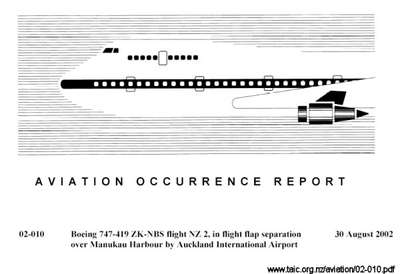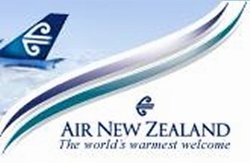Wed, Jul 02, 2003
Air NZ Didn't Do It: Report
New Zealand's Transport Accident Investigation Commission
has released its report on the loss of a flap from an ANZ 747 last
August. The attachment link came under suspicion, and was found to
have been the first point of failure; Boeing has since redesigned
the link. ANZ was not found to have done anything wrong in the
incident; no one was hurt, as the 372 people made it into LAX,
OK.

The TAIC Report:
Boeing 747-419, ZK-NBS, flight NZ 2, in-flight flap separation
over Manukau Harbour by Auckland International Airport On Friday 30
August 2002 at 2120, ZK-NBS (flight NZ 2), a Boeing 747-419, took
off from runway 23 at Auckland International Airport for Los
Angeles. On board were 355 passengers and 17 crew, including 3
pilots on duty in the cockpit.
During a left turn shortly after departure at night, with the
flaps still extended to the take-off setting, about 70% of the
right inboard trailing edge fore flap separated from the aircraft.
The pilots did not receive any cockpit indications of anything
untoward and only felt some slight bumps they thought to be from
turbulence. The crew were unaware of the separation until
the landing approach at Los Angeles some 12 hours later, when the
flaps were selected for landing. The pilots took the
appropriate action and carried out a go around procedure. The
aircraft was repositioned for a further approach and landed safely.
The safety of the aircraft and its occupants was not compromised by
the incident. No one was injured.
 The flap separated because
its inboard attachment link failed. The link failed because a
pre-existing stress corrosion crack had grown to a critical size,
probably in a short period of time. The operator had inspected the
flap assembly routinely and specifically as the aircraft
manufacturer required, but neither the start of the crack nor its
growth could be detected during those inspections.
The flap separated because
its inboard attachment link failed. The link failed because a
pre-existing stress corrosion crack had grown to a critical size,
probably in a short period of time. The operator had inspected the
flap assembly routinely and specifically as the aircraft
manufacturer required, but neither the start of the crack nor its
growth could be detected during those inspections.
A safety issue identified was the design adequacy of the fore
flap attachment links. The aircraft manufacturer has completed a
design change to overcome the limitations of the links.
More News
From 2023 (YouTube Version): Legacy of a Titan Robert (Bob) Anderson Hoover was a fighter pilot, test pilot, flight instructor, and air show superstar. More so, Bob Hoover was an i>[...]
Get The Latest in Aviation News NOW on Instagram Are you on Instagram yet? It's been around for a few years, quietly picking up traction mostly thanks to everybody's new obsession >[...]
Aero Linx: B-52H Stratofortress The B-52H Stratofortress is a long-range, heavy bomber that can perform a variety of missions. The bomber is capable of flying at high subsonic spee>[...]
Altimeter Setting The barometric pressure reading used to adjust a pressure altimeter for variations in existing atmospheric pressure or to the standard altimeter setting (29.92).>[...]
"Knowing that we play an active part in bettering people's lives is extremely rewarding. My team and I are very thankful for the opportunity to be here and to help in any way we ca>[...]
 Classic Aero-TV: Remembering Bob Hoover
Classic Aero-TV: Remembering Bob Hoover ANN FAQ: Follow Us On Instagram!
ANN FAQ: Follow Us On Instagram! ANN's Daily Aero-Linx (05.15.24)
ANN's Daily Aero-Linx (05.15.24) ANN's Daily Aero-Term (05.15.24):Altimeter Setting
ANN's Daily Aero-Term (05.15.24):Altimeter Setting Aero-News: Quote of the Day (05.16.24)
Aero-News: Quote of the Day (05.16.24)




